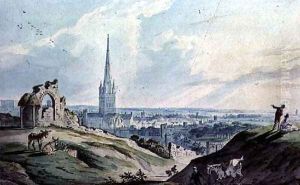Charles, II Catton Paintings
Charles Catton the younger, born in 1756 in London, England, was a distinguished British artist known for his landscape paintings, animal depictions, and contributions as an illustrator. He hailed from a family deeply rooted in the arts; his father, Charles Catton the elder (1728–1798), was a renowned coach painter and one of the founding members of the Royal Academy in 1768. This environment undoubtedly influenced young Charles and nurtured his artistic talents from an early age.
Catton's artistic journey was multifaceted, showcasing his versatility across different mediums. He initially gained recognition for his expertise in watercolors and oils, often depicting the English countryside and its wildlife with remarkable accuracy and sensitivity. His animal paintings, in particular, were celebrated for their lifelike portrayal and attention to detail, qualities that made his work highly sought after for book illustrations and private commissions.
In 1783, Charles Catton the younger embarked on a significant chapter of his career by traveling to India. This venture was driven by the era's burgeoning interest in exotic locales and the British Empire's expanding reach. During his time in India, Catton captured the vibrancy of the landscape and its inhabitants, both human and animal, in his sketches and paintings. These works contributed to the West's fascination with oriental scenes and were instrumental in shaping the picturesque view of India in British art.
Despite his success, Catton's career was not without its challenges. The competitive art scene of the time, combined with the evolving tastes of patrons and the public, required constant adaptation and innovation. Yet, Charles Catton the younger managed to sustain a respected position within the art community throughout his life.
Charles Catton the younger's death in 1819 marked the end of an era in British art. His contributions, particularly in the realms of landscape and animal painting, left an indelible mark on the artistic landscape of his time. Through his work, Catton not only provided a window into the diverse natural beauty of the English countryside and the exotic allure of India but also contributed to the evolution of British art in the late 18th and early 19th centuries.
